Table Of Contents
Nutrient Disorder Problem Solver = Use this to Diagnose the main culprits
The Nutrients:
Nitrogen Magnesium Potassium Phosphorous Iron Manganese Zinc Sulpur Chlorine Boron Copper
Molybdenum Sodium Silicon Cobalt Calcium
Enviromental Factors
Checking Water, Feeding Tips, Nutrient Solution Burn, Over Watering/ Lack of Disolved Oxygen, PH, Over Nitrification, Cold, Heat, Humidity, Mold and Fungus, Insects, Spray damage, Insufficient Light, Sick Clones, Ozone Damage
Nutrient Disorder Problem Solver
Version 1.1 - Feb. 1998 - distribution okay
To use the Problem-Solver, simply start at #1 below. When you think you've found the problem, read the Nutrients section to learn more about it. Diagnose carefully before making major changes.
1) If the problem affects only the bottom or middle of the plant go to #2. b) If it affects only the top of the plant or the growing tips, skip to #10. If the problem seems to affect the entire plant equally, skip to #6.
2) Leaves are a uniform yellow or light green; leaves die & drop; growth is slow. Leaf margins are not curled-up noticeably. >> Nitrogen(N) deficiency. b) If not, go to #3.
3) Margins of the leaves are turned up, and the tips may be twisted. Leaves are yellowing (and may turn brown), but the veins remain somewhat green. >> Magnesium (Mg) deficiency. b) If not, go to #4.
4) Leaves are browning or yellowing. Yellow, brown, or necrotic (dead) patches, especially around the edges of the leaf, which may be curled. Plant may be too tall. >> Potassium (K) deficiency. b) If not, keep reading.
5) Leaves are dark green or red/purple. Stems and petioles may have purple & red on them. Leaves may turn yellow or curl under. Leaf may drop easily. Growth may be slow and leaves may be small. >> Phosphorus(P) deficiency. b) If not, go to #6.
6) Tips of leaves are yellow, brown, or dead. Plant otherwise looks healthy & green. Stems may be soft >> Over-fertilization (especially N), over-watering, damaged roots, or insufficient soil aeration (use more sand or perlite. Occasionally due to not enough N, P, or K. b) If not, go to #7.
7) Leaves are curled under like a ram's horn, and are dark green, gray, brown, or gold. >> Over-fertilization (too much N). b) If not, go to #8.
8) The plant is wilted, even though the soil is moist. >> Over-fertilization, soggy soil, damaged roots, disease; copper deficiency (very unlikely). b) If not, go to #9.
9) Plants won't flower, even though they get 12 hours of darkness for over 2 weeks. >> The night period is not completely dark. Too much nitrogen. Too much pruning or cloning. b) If not, go to #10...
10) Leaves are yellow or white, but the veins are mostly green. >> Iron (Fe) deficiency. b) If not, go to #11.
11) Leaves are light green or yellow beginning at the base, while the leaf margins remain green. Necrotic spots may be between veins. Leaves are not twisted. >> Manganese (Mn) deficiency. b) If not, #12.
12) Leaves are twisted. Otherwise, pretty much like #11. >> Zinc (Zn) deficiency. b) If not, #13
The Nutrients:
Nitrogen -
Plants need lots of N during vegging, but it's easy to overdo it. Added too much? Flush the soil with plain water. Soluble nitrogen (especially nitrate) is the form that's the most quickly available to the roots, while insoluble N (like urea) first needs to be broken down by microbes in the soil before the roots can absorb it. Avoid excessive ammonium nitrogen, which can interfere with other nutrients. Too much N delays flowering. Plants should be allowed to become N-deficient late in flowering for best flavor.
Nitrogen is a key Element in the production of Amino Acids, which are the building block of Proteins. Many plant hormones contain Nitrogen as well as Chlorophyll, DNA and RNA (Genetic materials), and a myriad of enzymes that help control and regulate growth. Nitrogen is the most mobile element. 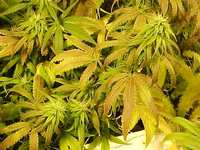
Plants suffering from this deficiency are distinct in their pattern of yellowing. Yellowing starts on the older leaves and progresses upward, leaving the top parts of the plant green.
Notice that the large fan leaves are yellowing and turning purple-ish. from the bottom up.
Feeding with a high N fert will clear it up, like an emulsion of fish at 5-1-1.
[Editor?s note: Leaves will turn pale green, then yellow evenly. There are no intervenial striping or yellow patches. Color is uniform over the entire leaf. Yellowing is expected during flushing, as the plant is using up all available internal nutrients]
Nitrogen (N)
Nitrate - Ammonium is found in both inorganic and organic forms in the plant, and combines with carbon, hydrogen, oxygen and sometimes sulfur to form amino acids, amino enzymes, nucleic acids, chlorophyll, alkaloids, and purine bases. Nitrogen rates high as molecular weight proteins in plant tissue.
Plants need lots of N during vegging, but it's easy to overdo it. Added too much? Flush the soil with plain water. Soluble nitrogen (especially nitrate) is the form that's the most quickly available to the roots, while insoluble N (like urea) first needs to be broken down by microbes in the soil before the roots can absorb it. Avoid excessive ammonium nitrogen, which can interfere with other nutrients.
Too much N delays flowering. Plants should be allowed to become N-deficient late in flowering for best flavor.
Nitrogen Deficiencies:
Plants will exhibit lack of vigor, slow growth and will be weak and stunted. Quality and yield will be significantly reduced. Older leaves become yellow (chlorotic) from lack of chlorophyll. Deficient plants will exhibit uniform light green to yellow on older leaves, these leaves may die and drop. Leaf margins will not curled up noticeably. Chlorosis will eventually spread throughout the plant. Stems, petioles and lower leaf surfaces may turn purple.
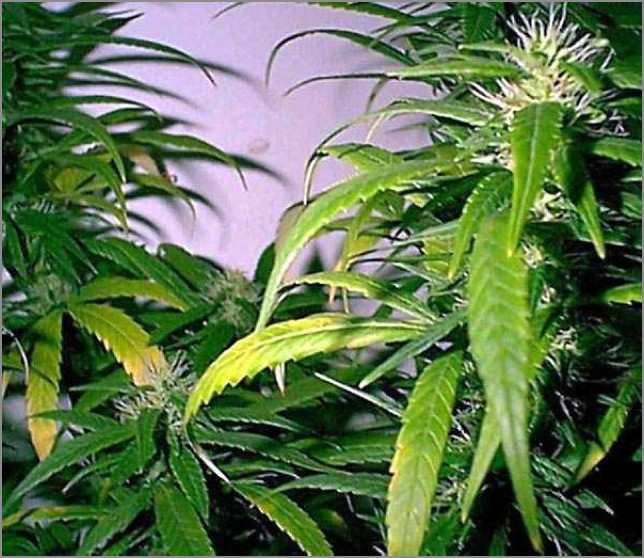
Figure 9
As seen in figure 10 consumption of nitrogen (N) from the fan leaves during the final phase of flowing is 100% normal.
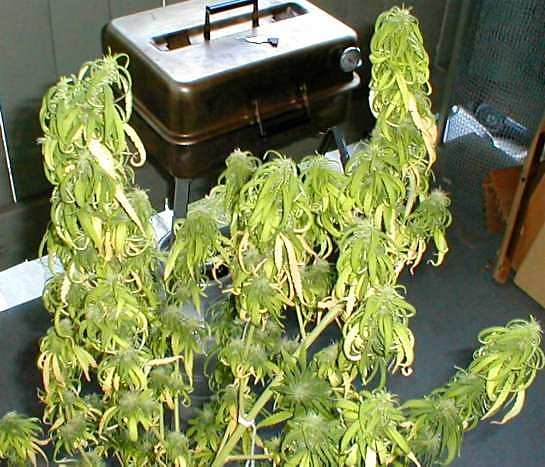
Figure 10
Nitrogen Toxicity:
Leaves are often dark green and in the early stages abundant with foliage. If excess is severe, leaves will dry and begin to fall off. Root system will remain under developed or deteriorate after time. Fruit and flower set will be inhibited or deformed.
With breakdown of vascular tissue restricting water uptake. Stress resistance is drastically diminished.
Return to Contents
Magnesium -
Mg-deficiency is pretty common since marijuana uses lots of it and many fertilizers don't have enough of it. Mg-deficiency is easily fixed with ¼ teaspoon/gallon of Epsom salts (first powdered and dissolved in some hot water) or foliar feed at ½ teaspoon/quart. When mixing up soil, use 2 teaspoon dolomite lime per gallon of soil for Mg. Mg can get locked-up by too much Ca, Cl or ammonium nitrogen. Don't overdo Mg or you'll lock up other nutrients.
Magnesium (Mg)
Magnesium is a component of the chlorophyll molecule and serves as a cofactor in most enzymes.
Magnesium (Mg) deficiency:
Magnesium deficiency will exhibit a yellowing (which may turn brown) and interveinal chlorosis beginning in the older leaves. The older leaves will be the first to develop interveinal chlorosis. Starting at leaf margin or tip and progressing inward between the veins. Notice how the veins remain somewhat green though as can be seen in figure 15.
Notice how in figure 16 and 17 the leaves curl upwards like they're praying? They're praying for Mg! The tips may also twist.
This can be quickly resolved by watering with 1 tablespoon Epsom salts/gallon of water. Until you can correct nutrient lockout, try foliar feeding. That way the plants get all the nitrogen and Mg they need. The plants can be foliar feed at ½ teaspoon/quart of Epsom salts (first powdered and dissolved in some hot water). When mixing up soil, use 2 teaspoon dolomite lime per gallon of soil.
If the starting water is above 200 ppm, that is pretty hard water, that will lock out mg with all of the calcium in the water. Either add a 1/4 teaspoon per gallon of epsom salts or lime (both will effectively reduce the lockout or invest into a reverse osmosis water filter.
Mg can get locked-up by too much Ca, Cl or ammonium nitrogen. Don't overdo Mg or you'll lock up other nutrients.
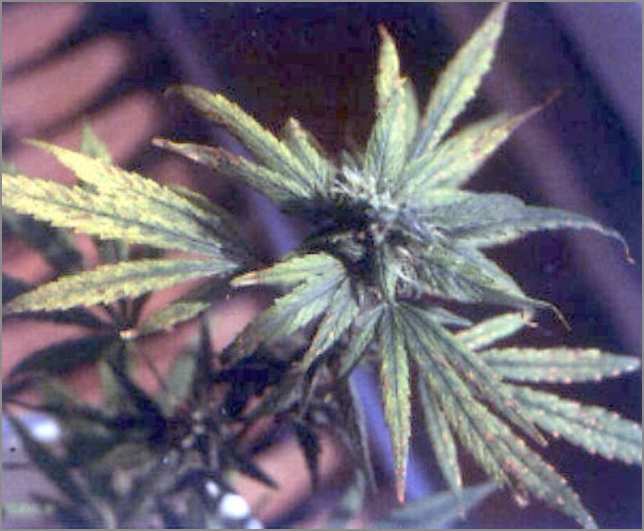
Figure 15
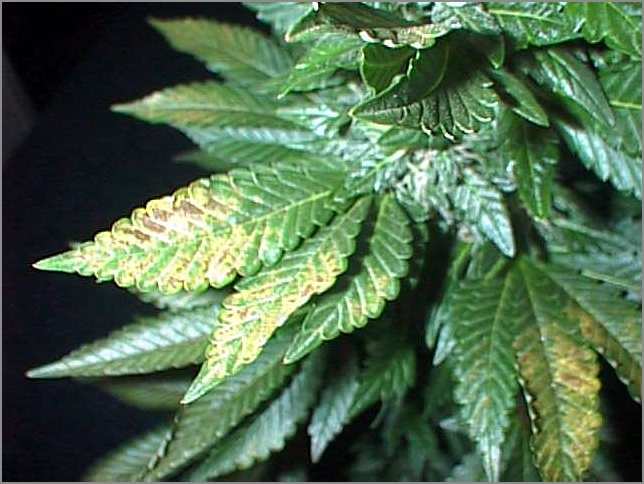
Figure 16
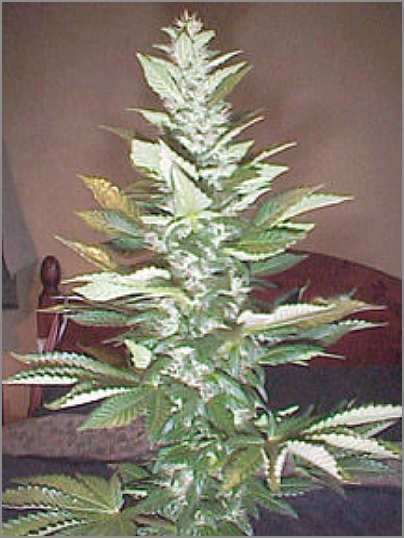
Figure 17
Magnesium (Mg) Toxicity:
Magnesium toxicity is rare and not generally exhibited visibly. Extreme high levels will antagonize other ions in the nutrient solution.
Return to Contents
Potassium -
Too much sodium (Na) displaces K, causing a K deficiency. Sources of high salinity are: baking soda (sodium bicarbonate "pH-up"), too much manure, and the use of water-softening filters (which should not be used). If the problem is Na, flush the soil. K can get locked up from too much Ca or ammonium nitrogen, and possibly cold weather.
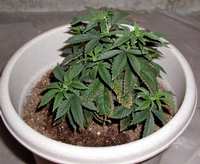 Potassium serves to aid in the process of photosynthesis, nutrient uptake, respiration, and is a key to sturdy stems and disease resistance. Having an adequate supply for the plant early in it?s life stage will keep your seedlings from falling over. Potassium serves to aid in the process of photosynthesis, nutrient uptake, respiration, and is a key to sturdy stems and disease resistance. Having an adequate supply for the plant early in it?s life stage will keep your seedlings from falling over.
Potassium deficiencies are identified by necrosis on the margins of larger fan leaves. Necrotic patches can be seen on the leaves as well. Leaves will eventually turn yellow, brown and die off. Most of the plants that show signs of a Potassium deficiency are going to be the tallest and best looking plants you have.
Again, feeding with a good all-around fertilizer will clear it up as well.
You can also use wood ashes and water them into your soil to fix this. You'll need to replace your soil's holding capacity of Potassium, and have a surplus before it will become available to the roots again.
Potassium (K)
Potassium is involved in maintaining the water status of the plant and the
tugor pressure of it's cells and the opening and closing of the stomata. Potassium is required in the accumulation and translocation of carbohydrates. Lack of potassium will reduce yield and quality.
Potassium deficiency:
Older leaves are initially chlorotic but soon develop dark necrotic lesions
(dead tissue). First apparent on the tips and margins of the leaves. Stem and branches may become weak and easily broken, the plant may also stretch. The plant will become susceptible to disease and toxicity. In addition to appearing to look like iron deficiency, the tips of the leaves curl and the edges burn and die.
Potassium - Too much sodium (Na) displaces K, causing a K deficiency. Sources of high salinity are: baking soda (sodium bicarbonate "pH-up"), too much manure, and the use of water-softening filters (which should not be used). If the problem is Na, flush the soil. K can get locked up from too much Ca or ammonium nitrogen, and possibly cold weather.
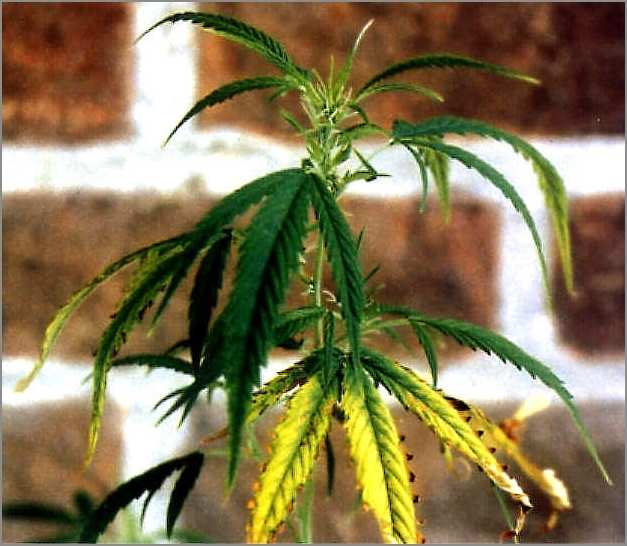
Figure 13
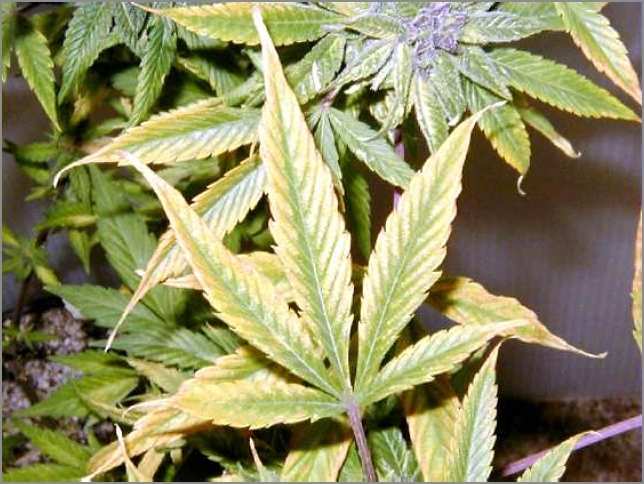
Figure 14
Potassium (K) Toxicity:
Usually not absorbed excessively by plants. Excess potassium can aggravate the uptake of magnesium, manganese, zinc and iron and effect the availability of calcium.
Return to Contents
Phosphorous -
Some deficiency during flowering is normal, but too much shouldn't be tolerated. Red petioles and stems are a normal, genetic characteristic for many varieties, plus it can also be a co-symptom of N, K, and Mg-deficiencies, so red stems are not a foolproof sign of P-deficiency. Too much P can lead to iron deficiency.
Phosphorus (P)
Phosphorus is a component of certain enzymes and proteins, adenosine triphosphate (ATP), ribonucleic acids (RNA), deoxyribonucleic acids (DNA) and phytin. ATP is involved in various energy transfer reactions, and RNA and DNA are components of genetic information.
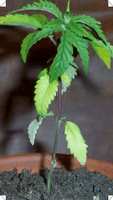
Phosphorous is used for plant energy by being assimilated into molecules called Adenosine-tri-phosphate, or ATP. This molecule is necessary for any plant activity that requires energy such as root growth, flowering, respiration, and vegetative growth.
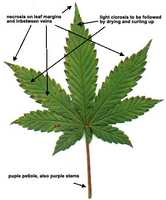 Phosphorous deficiencies are distinct. Purple stems, leaf stems, leaf veins and stunted growth are a sure sign of a Phosphorous deficiency. Leaves will also tend to be smaller and dark green, and may or may not include necrotic patches. Bud size will be smaller and underdeveloped, as will the root mass. Phosphorous deficiencies are distinct. Purple stems, leaf stems, leaf veins and stunted growth are a sure sign of a Phosphorous deficiency. Leaves will also tend to be smaller and dark green, and may or may not include necrotic patches. Bud size will be smaller and underdeveloped, as will the root mass.
A good all-around fertilizer like Peter's 20-20-20 will clear this up.
Phosphorus (P) deficiency:
Figure 11 is severe phosphorus (P) deficiency during flowering. Fan leaves are dark green or red/purple, and may turn yellow. Leaves may curl under, go brown and die. Small-formed buds are another main symptom.
Phosphorus deficiencies exhibit slow growing, weak and stunted plants with dark green or purple pigmentation in older leaves and stems.
Some deficiency during flowering is normal, but too much shouldn't be tolerated. Red petioles and stems are a normal, genetic characteristic for many varieties, plus it can also be a co-symptom of N, K, and Mg-deficiencies, so red stems are not a foolproof sign of P-deficiency. Too much P can lead to iron deficiency.
Purpling: accumulation of anthocyanin pigments; causes an overall dark green color with a purple, red, or blue tint, and is the common sign of phosphate deficiency. Some plant species and varieties respond to phosphate deficiency by yellowing instead of purpling. Purpling is natural to some healthy ornamentals.
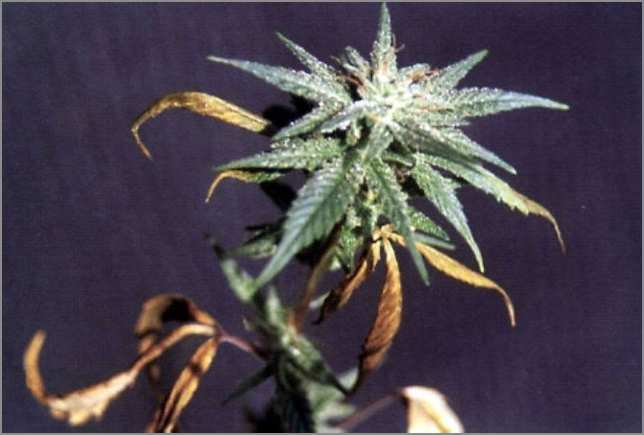
Figure 11
Figure 12 shows Phosphorus (P) deficiency during vegatative growth. Many people mistaken this for a fungus, but look for the damage to occur near the end of leave, and leaves the color dull greyish with a very brittle texture.
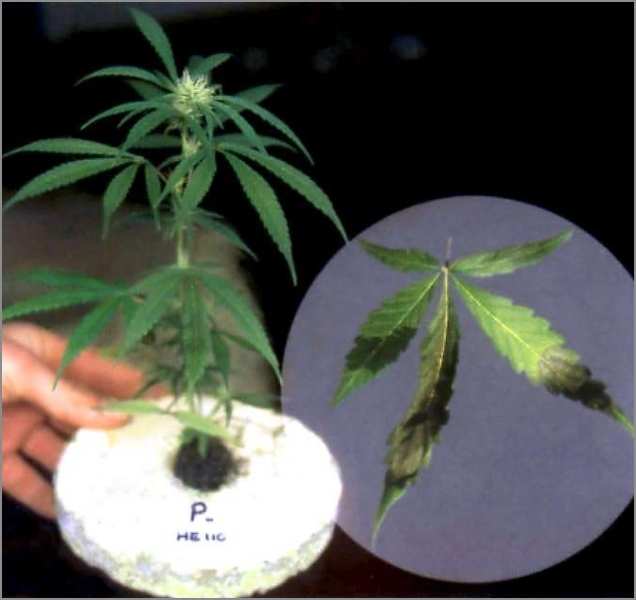
Figure 12
Phosphorus (P) Toxicity:
This condition is rare and usually buffered by pH limitations. Excess phosphorus can interfere with the availability and stability of copper and zinc.
Return to Contents
Iron -
Fe is unavailable to plants when the pH of the water or soil is too high. If deficient, lower the pH to about 6.5 (for rockwool, about 5.7), and check that you're not adding too much P, which can lock up Fe. Use iron that's chelated for maximum availability. Read your fertilizer's ingredients - chelated iron might read something like "iron EDTA". To much Fe without adding enough P can cause a P-deficiency.
An Iron deficiency will mask a Magnesium deficiency. If you look at the newer growth, that will be where the plant exhibits the intervenial chlorosis typically differentiating it from a Magnesium deficiency. 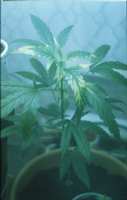
Notice how the top of the plant is exhibiting intervenial chlorosis and the lower part is unaffected.
Iron (Fe)
Iron is an important component of plant enzyme systems for electron transport to carry electrons during photosynthesis and terminal respiration. It is a catalyst for chlorophyll production and is required for nitrate and sulfate reduction and assimilation.
Iron deficiency:
- Pronounced interveinal chlorosis similar to that caused by magnesium deficiency but on the younger leaves.
-Leaves exhibit chlorosis (yellowing) of the leaves mainly between the veins, starting with the lower and middle leaves.
Caused by factors that interfere with iron absorption of roots: over irrigation, excessive soluble salts, inadequate drainage, pests, high substrate pH, or nematodes. This is easily corrected by adding an iron supplement with the next watering.
Fe is unavailable to plants when the pH of the water or soil is too high. If deficient, lower the pH to about 6.5 (for rockwool, about 5.7), and check that you're not adding too much P, which can lock up Fe. Use iron that's chelated for maximum availability. Read your fertilizer's ingredients - chelated iron might read something like "iron EDTA". To much Fe without adding enough P can cause a P-deficiency.
Note : When adding iron to the solution, it is often necessary to not use fertilizer for that watering. Iron has a tendency of reacting with many of the components of fertilizer solutions, and will cause nutrient lockup to occur. Read the labels of both the iron supplement and the fertilizer you are using before you attempt to combine the two.
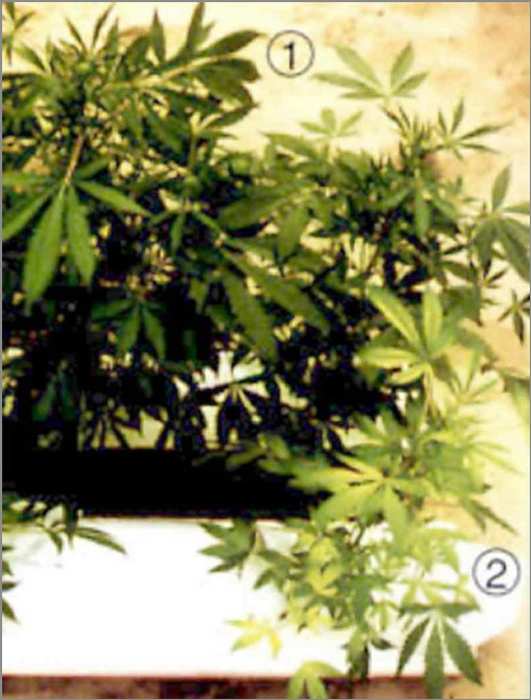
Figure 20
Iron Toxicity:
Excess accumulation is rare but could cause bronzing or tiny brown spots on leaf surface.
Return to Contents
Manganese -
Mn gets locked out when the pH is too high, and when there's too much iron. Use chelated Mn.
A Manganese deficiency exhibits a general chlorosis, followed by yellowing patches and necrotic patches between the veins of the larger fan leaves.
Magnesium
Chlorophyll has the same structure as Hemoglobin, except that it has a magnesium atom in place of the Iron atom. Chlorophyll is how plants make sugars to feed the process of building ATP through the Krebs cycle.
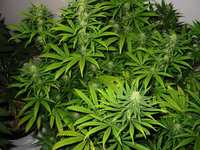 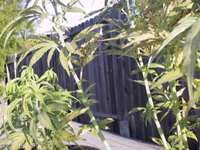
A magnesium deficient plant is identified by intervenial chlorosis, necrosis, and eventually a lockout of plant nutrients. The problems starts at the bottom of the plants and works it?s way up.
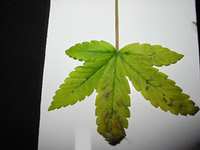
These images depict different stages and signs of a magnesium deficiency. The first picture is a Mg deficient plant in flower, and the second two are of the leaves to show what I mean by Intervenial Chlorosis.
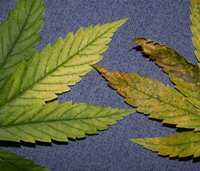
Treating with an Epsom salts mix will clear this right up.
Manganese (Mn)
Manganese is involved in the oxidation reduction process in the photosynthetic electron transport system. Biochemical research shows that this element plays a structural role in the chloroplast membrane system, and also activates numerous enzymes.
Manganese Deficiency:
Interveinal chlorosis of younger leaves, necrotic lesions and leaf shredding are typical symptom of this deficiency. High levels can cause uneven distribution of chlorophyll resulting in blotchy appearance. Restricted growth and failure to mature normally can also result.
-Mn gets locked out when the pH is too high, and when there's too much iron. Use chelated Mn.
Manganese Toxicity:
Toxicity:Chlorosis, or blotchy leaf tissue due to insufficient chlorophyll synthesis. Growth rate will slow and vigor will decline.
Return to Contents
Zinc -
Also gets locked out due to high pH. Zn, Fe, and Mn deficiencies often occur together, and are usually from a high pH. Don't overdo the micro-nutrients-lower the pH if that's the problem so the nutrients become available. Foliar feed if the plant looks real bad. Use chelated zinc.
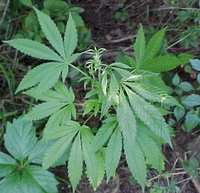 A Zinc deficient plant is obvious from the wispy new growth with twisted leaflets at 90°. There is also intervenial chlorosis at the top of the plant that is commonly confused with an Iron deficiency. A Zinc deficient plant is obvious from the wispy new growth with twisted leaflets at 90°. There is also intervenial chlorosis at the top of the plant that is commonly confused with an Iron deficiency.
Notice in this picture that the older grown leaves are relatively unaffected and healthy
Zinc (Zn)
Zinc plays a roll in the same enzyme functions as manganese and magnesium. More than eighty enzymes contain tightly bound zinc essential for their function. Zinc participates in chlorophyll formation and helps prevent chlorophyll destruction. Carbonic anhydrate has been found to be specifically activated by zinc.
Zinc Deficiencies:
Deficiencies appear as chlorosis in the inter-veinal areas of new leaves producing a banding appearance as seen in figure 18. This may be accompany reduction of leaf size and a shortening between internodes. Leaf margins are often distorted or wrinkled. Branch terminals of fruit will die back in severe cases.
Also gets locked out due to high pH. Zn, Fe, and Mn deficiencies often occur together, and are usually from a high pH. Don't overdo the micro-nutrients, lower the pH if that's the problem so the nutrients become available. Foliar feed if the plant looks real bad. Use chelated zinc. Zinc deficiency produces "little leaf" in many species, especially woody ones; the younger leaves are distinctly smaller than normal. Zinc defeciency may also produce "rosetting"; the stem fails to elongate behind the growing tip, so that the terminal leaves become tightly bunched.
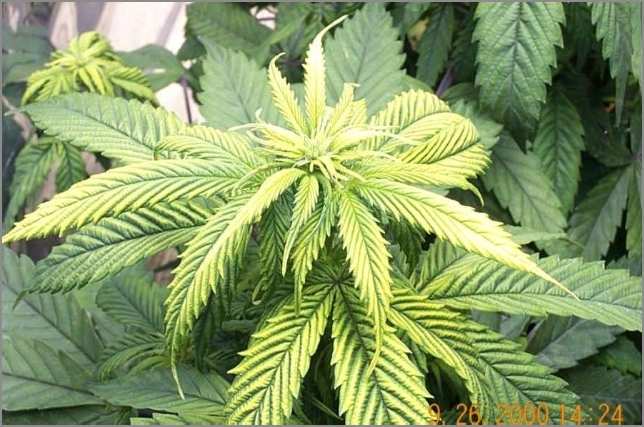
Figure 18
Zinc Toxicity:
Excess Zinc is extremely toxic and will cause rapid death. Excess zinc interferes with iron causing chlorosis from iron deficiency. Excess will cause sensitive plants to become chlorotic.
Return to Contents
Sulphur (S)
Sulfate is involved in protein synthesis and is part of the amino acids, cystine and thiamine, which are the building blocks of proteins. It is active in the structure and metabolism in the plant. It is essential for respiration and the synthesis and breakdown of fatty acids.
Sulphur (S) deficiency:
The initial symptoms are the yellowing of the entire leaf including veins usually starting with the younger leaves. Leaf tips may yellow and curl downward. Sulfur deficiencies are light green fruit or younger leaves with a lack of succulence. Elongated roots and woody stem. Although it's hard to see in figure 19, the upper stems of this plant are purple. Although many varieties of cannabis do get purplish stems, the trait generally extends the entire length of the plant's stem, and not just near the top as in this specimen.
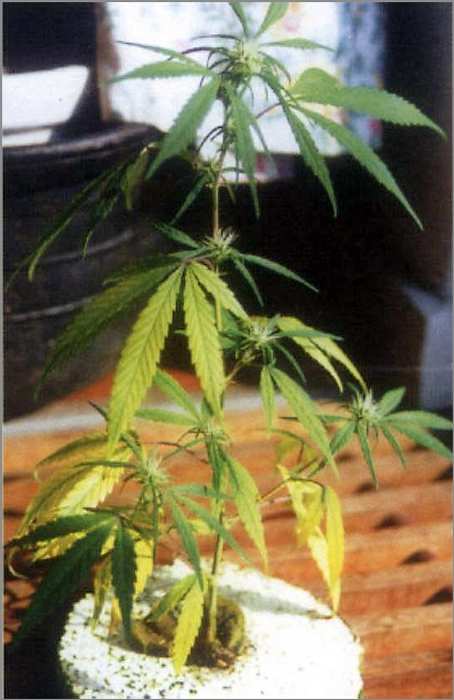
Figure 19
Sulphur Toxicity:
Leaf size will be reduced and overall growth will be stunted. Leaves yellowing or scorched at edges. Excess may cause early senescence.
Return to Contents
Chlorine (Cl)
Chloride is involved in the evolution of oxygen in the photosynthesis process and is essential for cell division in roots and leaves. Chlorine raises the cell osmotic pressure and affects stomata regulation and increases the hydration of plant tissue. Levels less than 140 ppm are safe for most plants. Chloride sensitive plants may experience tip or marginal leaf burn at concentrations above 20 ppm.
Chlorine Deficiency:
Wilted chlorotic leaves become bronze in color. Roots become stunted and thickened near tips. Plants with chlorine deficiencies will be pale and suffer wilting.
Chlorine Toxicity:
Burning of leaf tip or margins. Bronzing, yellowing and leaf splitting. Reduced leaf size and lower growth rate.
Return to Contents
Boron (B)
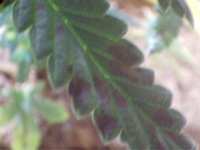 This is a rare occurrence and is exemplified by small gray or necrotic patches on the growing shoots which eventually die. This is a rare occurrence and is exemplified by small gray or necrotic patches on the growing shoots which eventually die.
Fixing this is done easily by applying a foliar spray of eyewash containing Boric Acid. This picture is not really the best IMO, but it shows a gray patch on a leaf that is indicative of what to look for. This will most likely occur in outdoor grows.
Boron biochemical functions are yet uncertain, but evidence suggests it is involved in the synthesis of one of the bases for nucleic acid (RNA uracil) formation. It may also be involved in some cellular activities such as division, differentiation, maturation and respiration. It is associated with pollen germination.
Boron Deficiency:
Plants deficient in boron exhibit brittle abnormal growth at shoot tips and one of the earliest symptoms is failure of root tips to elongate normally. Stem and root apical meristems often die. Root tips often become swollen and discolored. Internal tissues may rot and become host to fungal disease. Leaves show various symptoms which include drying, thickening, distorting, wilting, and chlorotic or necrotic spotting.
Boron Toxicity:
Yellowing of leaf tip followed by necrosis of the leaves beginning at tips or margins and progressing inward before leaves die and prematurely fall off. Some plants are especially sensitive to boron accumulation.
Return to Contents
Copper (Cu)
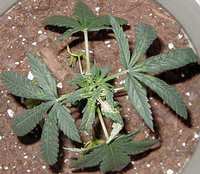 A copper deficiency is commonly mistaken for an over fertilization problem, but it is set apart by the growing tips dieing off first along with the crispy leaves. The new shoots will die from the tips and margins first, often going brown or even white before they die. A copper deficiency is commonly mistaken for an over fertilization problem, but it is set apart by the growing tips dieing off first along with the crispy leaves. The new shoots will die from the tips and margins first, often going brown or even white before they die.
A foliar feeding with a commercial fungicide containing Copper (ie. Copper Sulphate) will clear it up, but the damaged leaves may never recover.
Copper is a constituent of many enzymes and proteins. Assists in carbohydrate metabolism, nitrogen fixation and in the process of oxygen reduction.
Copper Deficiency:
Symptoms of deficiency are a reduced or stunted growth with a distortion of the younger leaves and growth tip die-back. Young leaves often become dark green and twisted. They may die back or just exhibit necrotic spots. Growth and yield will be deficient as well.
Copper Toxicity:
Copper is required in very small amounts and readily becomes toxic in solution culture if not carefully controlled. Excess values will induce iron deficiency. Root growth will be suppressed followed by symptoms of iron chlorosis, stunting, reduced branching, abnormal darkening and thickening of roots.
Return to Contents
Molybdenum (Mo)
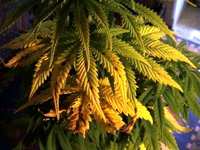 A Molybdenum deficient plant will exhibit yellowing necrotic leaves from the tips inward, with necrotic lesions present from the tips inward. A very distinctive feature is that it occurs in the middle of the plant. It also may spread to the rest of the plant if not stopped, eventually killing your plant. A Molybdenum deficient plant will exhibit yellowing necrotic leaves from the tips inward, with necrotic lesions present from the tips inward. A very distinctive feature is that it occurs in the middle of the plant. It also may spread to the rest of the plant if not stopped, eventually killing your plant.
Fritted Trace Elements may be added to your soil mix as you prepare it for planting. A good Hydroponic nutrient should contain ample micros to get your plant through its lifecycle.
Molybdenum is a component of two major enzyme systems involved in the nitrate reeducates, this is the process of conversion of nitrate to ammonium.
Molybdenum Deficiencies:
Often interveinal chlorosis which occurs first on older leaves, then progressing to the entire plant. Developing severely twisted younger leaves which eventually die. Molybdenum deficiencies frequently resemble nitrogen, with older leaves chlorotic with rolled margins and stunted growth.
Molybdenum Toxicity:
Excess may cause discoloration of leaves depending on plant species. This condition is rare but could occur from accumulation by continuous application. Used by the plant in very small quantities. Excess mostly usually does not effect the plant, however the consumption of high levels by grazing animals can pose problems so she might not be too good to smoke.
Return to Contents
Sodium (Na)
Sodium seems to encourage crop yields and in specific cases it acts as an antidoting agent against various toxic salts. It may act as a partial substitute for potassium deficiencies. Excess may cause plant toxicity or induce deficiencies of other elements. If sodium predominates in the solution calcium and magnesium may be affected.
Return to Contents
Silicon (Si)
Silicon usually exists in solution as silicic acid and is absorbed in this form. It accumulates as hydrated amorphous silica most abundantly in walls of epidermal cells, but also in primary and secondary walls of other cells. It is largely available in soils and is found in water as well. Inadequate amounts of silicon can reduce tomato yields as much as 50%, cause new leaves to be deformed and inhibit fruit set. At this time toxicity symptoms are undetermined.
Return to Contents
Cobalt (Co)
Cobalt is essential to many beneficial bacteria that are involved in nitrogen fixation of legumes. It is a component of vitamin B12 which is essential to most animals and possibly in plants. Reports suggest that it may be involved with enzymes needed to form aromatic compounds. Otherwise, it is not understood fully as to its benefit to plant growth, but it is considered essential to some animal health issues.
Return to Contents
Calcium
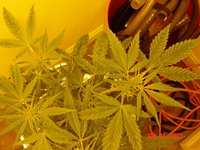 Calcium is an important co-enzyme in the production of fatty acids, cell membranes, and is necessary for normal mitosis/cell division. A Ca deficiency will stunt plant growth. Acidic soils may increase the risk of a Ca def. Calcium is an important co-enzyme in the production of fatty acids, cell membranes, and is necessary for normal mitosis/cell division. A Ca deficiency will stunt plant growth. Acidic soils may increase the risk of a Ca def.
Return to Contents
Enviromental Factors
Check Your Water -
Crusty faucets and shower heads mean your water is "hard," usually due to too many minerals. Tap water with a TDS (total dissolved solids) level of more than around 200ppm (parts per million) is "hard" and should be looked into, especially if your plants have a chronic problem. Ask your water company for an analysis listing, which will usually list the pH, TDS, and mineral levels (as well as the pollutants, carcinogens, etc) for the tap water in your area. This is a common request, especially in this day and age, so it shouldn't raise an eyebrow. Regular water filters will not reduce a high TDS level, but the costlier reverse-osmosis units, distillers, and de-ionizers will. A digital TDS meter (or EC = electrical conductivity meter) is an incredibly useful tool for monitoring the nutrient levels of nutrient solution, and will pay for itself before you know it. They run about $40 and up.
Return to Contents
General Feeding Tips -
Pot plants are very adaptable, but a general rule of thumb is to use more nitrogen & less phosphorous during the vegetative period, and the exact opposite during the flowering period. For the veg. period try a N:P:K ratio of about 10:7:8 (which of course is the same ratio as 20:14:16), and for flowering plants, 4:8:8. Check the pH after adding nutrients. If you use a reservoir, keep it circulating and change it every 2 weeks. A general guideline for TDS levels is as follows:
seedlings = 50-150 ppm; unrooted clones = 100-350 ppm; small plants = 400-800 ppm; large plants = 900-1800 ppm; last week of flowering = taper off to plain water. These numbers are just a guideline, and many factors can change the actual level the plants will need. Certain nutrients are "invisible" to TDS meters, especially organics, so use TDS level only as an estimate of actual nutrient levels. When in doubt about a new fertilizer, follow the fertilizer's directions for feeding tomatoes. Grow a few tomato or radish plants nearby for comparison.
Return to Contents
Nutrient Solution Burn:
Over Fertilization
This is a very common problem that can be disguised as an improper pH, or light burning, as well as a myriad of other problems.
The first picture masks as over Nitrification, but notice how the entire leaf is curled under, not just the tip.
This photo displays many problems associated with overferting, some of which could be a simple imbalance of pH and a certain nutrient/micro lockout at the given pH.
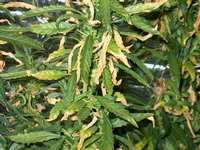 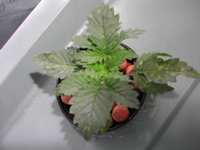
There's a good chance that this leaf was subjected to nutrient solution burn. These symptoms are seen when the EC concentration of hydroponic solutions is too high. These symptoms also appear when strong nutrient solution is splashed onto the leaves under hot HID lamps, causing the leaves to burn under the solution.
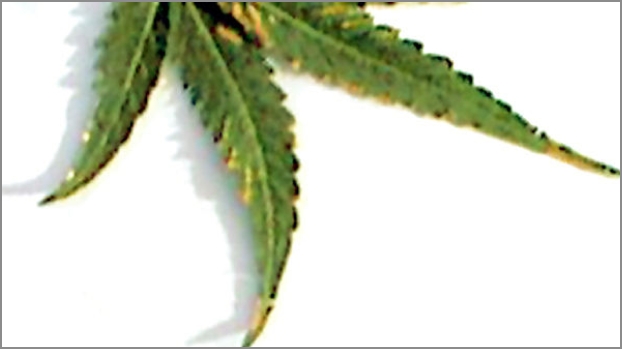
Figure 2
Many hydroponic gardeners see this problem. It's the beginning of nutrient burn. It indicates that the plants have all the nutrients they can possibly use, and there's a slight excess. Back off the concentration of the nutrient solution just a touch, and the problem should disappear. Note that if the plants never get any worse than this leaf (figure 3), then the plants are probably just fine. Figure 4 is definitely an over-fert problem. The high level of nutrients accumulates in the leaves and causes them to dry out and burn up as shown here. You must flush with clear, clean water immediately to allow the roots to recover, and prevent further damage. Now find the cause of the high nutrient levels.
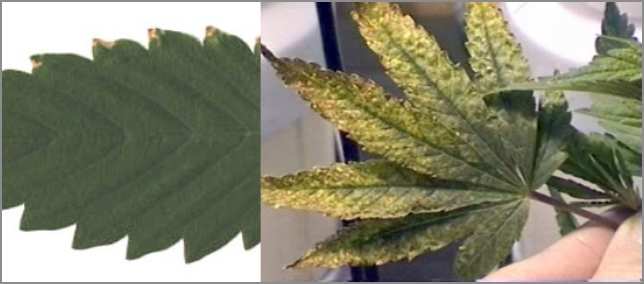
Figure 3 (left) and Figure 4 (right)
Return to Contents
Over watering/ lack of Dissolved Oxygen:
Droopy leaves and lower leaf yellowing are indications of persistent over watering problems.
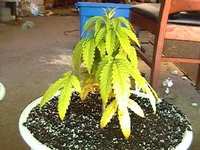 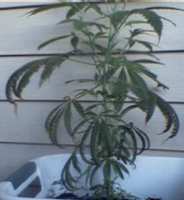
The plants in figure 5 were on a continous drip system, where nutrient solution is constantly being pumped into the medium. This tends to keep the entire root system completely saturated. A better way would be to periodically feed the plants, say for 1/2 hour every 2-3 hours. This would give the roots a chance to get needed air to them, and prevent root rot and other problems.
Don't be throw off by the fact that the plants in figure 5 are sitting in still water, this is actually an H2O2 solution used to try and correct the problem. Adding an airstone to the tub would also help add O2 to the solution.
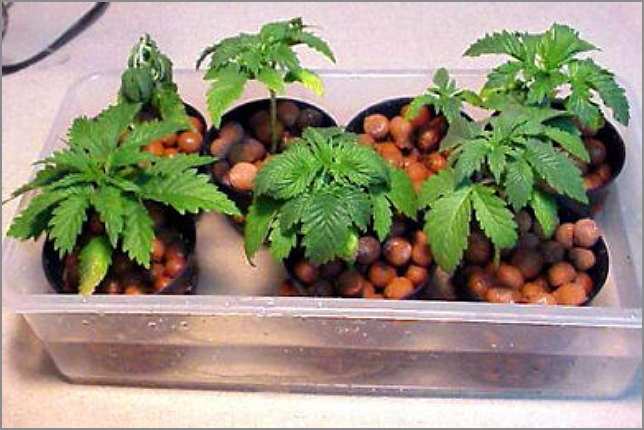
Figure 5
Return to Contents
PH -
Improper pH can cause an abundance of problems that you might easily confuse with other problems or deficiencies.
A pH imbalance may also be the cause of the deficiencies in the first place. pH in soil is best in the range of 6 up to 7.5, and in a Hydroponic system it?s best at 5.2-5.8.
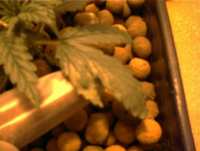 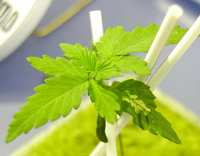
The pH of water after adding any nutrients should be around 5.9-6.5 (in rockwool, 5.5-6.1). Generally speaking, the micro-nutrients (Fe, Zn, Mn, Cu) get locked out at a high pH (alkaline) above 7.0, while the major nutrients (N, P, K, Mg) can be less available in acidic soil or water (below 5.0). Tap water is often too alkaline. Soils with lots of peat or other organic matter in them tend to get too acidic, which some dolomite lime will help fix. Soil test kits vary in accuracy, and generally the more you pay the better the accuracy. For the water, color-based pH test kits from aquarium stores are inexpensive, but inaccurate. Invest in a digital pH meter ($40-80), preferably a waterproof one. You won't regret it.
pH Fluctuation:
Both of these leaves in figure 6 and figure 7 are from the same plant. It could be over fertilization, but more likely it is due to the pH being off. Too high or too low a pH can lock up nutrients in the form of undisolvable salts and compounds, some of which are actually toxic to the plants. What then happens is the grower then tries to supplement the plants diet by adding more fertilizers, throwing off the pH even more and locking up even more nutrients. This type of problem is seen more often in soil mixes, where inconsistent mixing of the medium's components leads to "hot" spots.
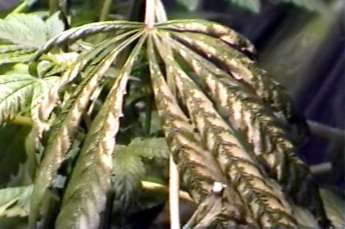 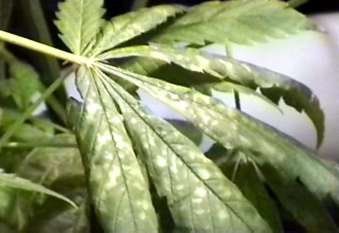
Figure 6 (left) and Figure 7 (right)
Return to Contents
Over Nitrification - 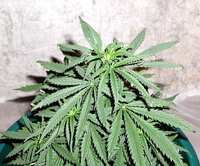
The following pictures show the ?claw?: indicative of over Nitrification. Some growers loadup their plants with Nitrogen prior to flowering. This will prepare them for the stretch to follow, and will increase bud production if induced a few weeks prior to blooming the plant.
|
Return to Contents
Cold -
Cold weather (below 50F/10C) can lock up phosphorous. Some
varieties, like equatorial sativas, don't take well to cold weather. If you can keep the roots warmer, the plant will be able to take cooler temps than it otherwise could.
Return to Contents
Heat -
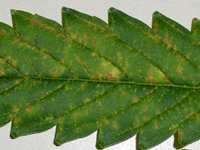 [Editor's note: Radiant heat is also called ?light burn?. Typically, topmost leaves will become pale green, then turn brown as the burn progresses. Plants on the outmost edge of the garden will remain a healthy dark green, with light burned plants directly underneath the reflectors in a circular pattern.] [Editor's note: Radiant heat is also called ?light burn?. Typically, topmost leaves will become pale green, then turn brown as the burn progresses. Plants on the outmost edge of the garden will remain a healthy dark green, with light burned plants directly underneath the reflectors in a circular pattern.]
If the lights are too close to the plant, the tops may be curled, dry, and look burnt, mimicking a nutrient problem. Your hand should not feel hot after a minute when you hold it at the top of the plants. Raise the lights and/or aim a fan at the hot zone. Room temps should be kept under 85F (29C) -- or 90F (33) if you add additional CO2.
Look closely below, and you'll see the brown leaf edges that are indicative of heat stress. This damage looks alot like nutrient burn, except it occurs only at the tops of the plants closest to the lamps. There's only one cure for this...get the heat away from the plants, either by moving the lamps or moving the plants.
Humidity -
Thin, shriveled leaves can be from low humidity. 40-80 % is usually fine.
Return to Contents
Mold and Fungus -
Dark patchy areas on leaves and buds can be mold. Lower the humidity and increase the ventilation if mold is a problem. Remove any dead leaves, wherever they are. Keep your garden clean.
Return to Contents
Insects -
White spots on the tops of leaves can mean spider mites
underneath.
Return to Contents
Sprays -
Foliar sprays can have a "magnifying glass" effect under bright lights, causing small white, yellow or burnt spots which can be confused with a nutrient problem. Some sprays can also cause chemical reactions.
Return to Contents
Insufficient light -
tall, stretching plants are usually from using the wrong kind of light.. Don't use regular incandescent bulbs ("grow bulbs") or halogens to grow cannabis. Invest in fluorescent lighting (good) or HID lighting (much better) which supply the high-intensity light
that cannabis needs for good growth and tight buds. Even better, grow in sunlight.
Return to Contents
Clones -
yellowing leaves on unrooted clones can be from too much light, or the stem may not be firmly touching the rooting medium. Turn off any CO2 until they root. Too much fertilizer can shrivel or wilt clones - plain tap water is fine.
Return to Contents
Ozone Damage -
Ozone damage typically found near the generator. Although a rare problem, symptoms generally appear as a Mg deficiency, but the symptoms are localized to immediately around the generator.
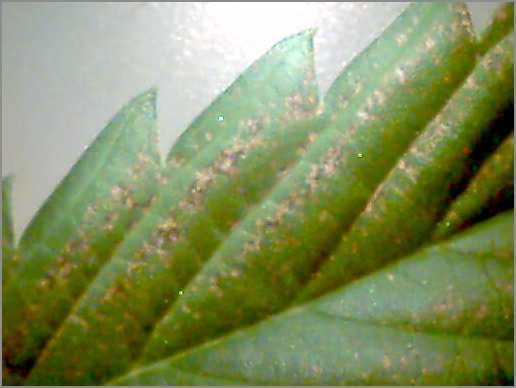
Return to Contents
|